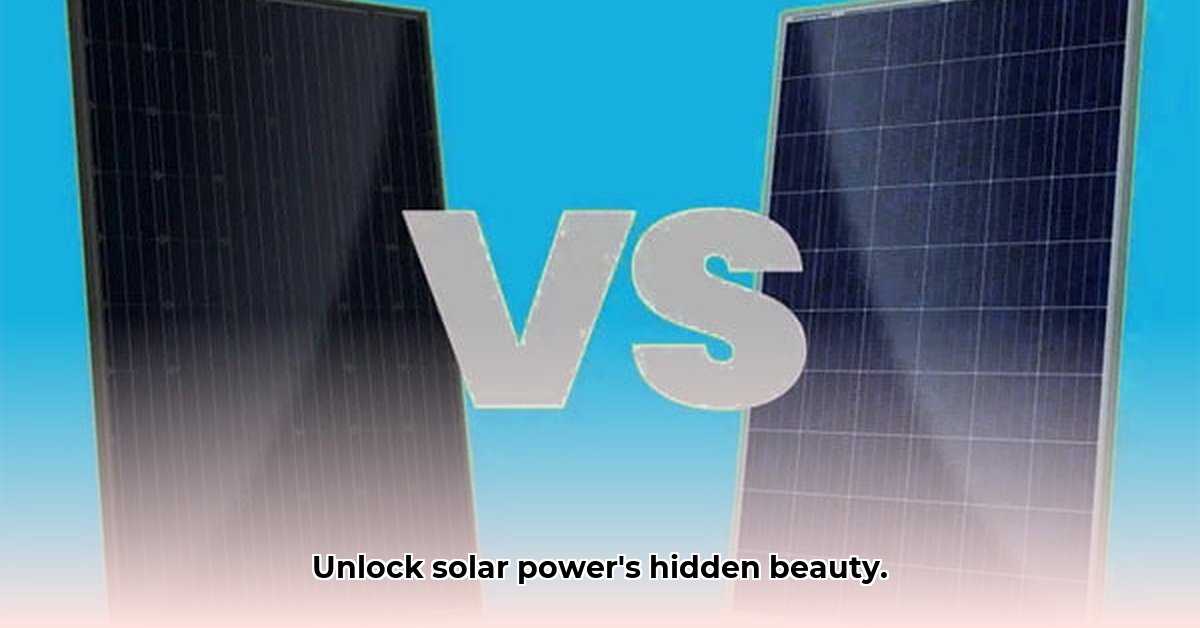Choosing the perfect solar panels can be complex, especially with so many color options available. However, color isn’t just about aesthetics; it significantly impacts the panel’s efficiency, cost, and longevity. This guide will help you understand the science behind different solar panel colors and how to choose the best ones for your needs. We’ll compare the pros and cons of various colors, focusing on efficiency, aesthetics, and cost. You’ll learn how to select the right color for your home or business, get tips on maximizing your panels’ performance, and discover the latest advancements in solar panel technology. By the end, you’ll be equipped to choose the ideal solar panel color and optimize your clean energy investment.
Solar Energy Colors: Aesthetics and Efficiency in Harmony
Solar panels convert sunlight into clean, usable energy. Traditionally, they’ve been predominantly black or blue, but the solar industry now offers a spectrum of colors. Selecting the right color impacts the panel’s power output and aesthetic appeal.
The Colorful World of Solar Power: More Than Just Black and Blue
While black and blue solar panels have been the standard for years, the rise of alternative colors is growing. Black panels, often made of monocrystalline silicon, are known for their high performance due to increased sunlight absorption. However, this superior performance often comes at a higher price point. Blue panels, typically made from polycrystalline silicon, are more affordable but may not generate as much electricity.
The expanding range of colors, including reds, greens, and custom shades, allows for seamless integration into homes and buildings. The goal is to blend solar panels with the existing architecture, making them a visually appealing part of the building rather than a separate, industrial component.
Color, Efficiency, and Cost: Finding the Sweet Spot
A solar panel’s color significantly impacts how well it absorbs sunlight. Darker colors typically absorb more light, potentially increasing energy production. However, the relationship between color and efficiency isn’t always straightforward. While black panels often lead in efficiency, they also tend to be more expensive. Blue panels strike a balance between cost and performance, offering a more budget-friendly option with slightly lower energy output.
The colors you see are achieved through specific coatings or manufacturing processes, which can sometimes slightly reduce efficiency compared to standard black or blue panels. The extent of this reduction depends on the technology used; ongoing research aims to improve the efficiency of colored panels.
Beyond Efficiency: The Beauty of Blending In
The increased popularity of colored solar panels reflects a growing demand for improved aesthetics. People want solar panels that are both functional and visually appealing, seamlessly integrating into their designs and enhancing their property’s appearance. Homeowners and businesses are increasingly willing to consider a slight trade-off in energy production for a more aesthetically pleasing system, balancing clean energy generation with visual harmony.
Your Guide to Choosing the Right Solar Panel Color
Selecting the right solar panel color involves a thoughtful process. Here’s a step-by-step guide to help you make an informed decision:
Step 1: Define Your Priorities: Determine what’s most important to you – maximum energy production or a specific aesthetic that complements your home’s style.
Step 2: Set a Realistic Budget: Recognize that higher-efficiency panels (often darker colors) typically cost more. Decide how much you’re willing to invest to meet your energy and aesthetic needs.
Step 3: Consider Your Property: Evaluate your roof, the surrounding environment, and how different colors might blend in or stand out.
Step 4: Research Panel Options: Compare different colors and styles from various manufacturers, paying attention to efficiency ratings, warranties, and price. Read independent reviews to understand real-world performance.
Step 5: Consult the Pros: Seek advice from solar installers. Their expertise can help you choose the best panels for your specific location, energy needs, and aesthetic preferences.
The Future is Bright (and Colorful!): Ongoing Research and Innovation
The field of colored solar panels is continuously evolving. Researchers are dedicated to improving the efficiency of colored panels without compromising their aesthetic appeal. Expect to see new materials and manufacturing processes that push the boundaries of both performance and design, making it an exciting time to explore solar power options.
Weighing the Pros and Cons: Colored vs. Traditional Panels
Here’s a comparison of colored panels versus traditional black and blue options:
| Feature | Pros | Cons |
|---|---|---|
| Aesthetics | Wide range of colors; improved integration with building design | Limited color options currently widely available; potential for fading |
| Efficiency | Potential for improved light absorption in specific wavelengths | May produce slightly less electricity than some black or blue panels |
| Cost | Varies widely based on the technology; it could be similar to, or more expensive than traditional panels | Some colored options can have a higher price tag |
| Availability | Increasingly more options are becoming available | Slower adoption compared to standard black and blue panels |
Choosing the “best” panel depends on your individual priorities and budget. Carefully weigh your options, conduct thorough research, and consult experts. The solar energy landscape is dynamic and offers a wide array of choices.
How to Choose the Best Solar Panel Color for Maximum Efficiency and Aesthetics
- Darker colors generally absorb more sunlight, boosting energy production, but may overheat in warmer climates.
- Lighter colors reflect heat, improving performance in hotter regions, but at the cost of lower energy generation.
- The ideal color is context-dependent, balancing efficiency with aesthetics and climate.
Balancing Act: Efficiency vs. Aesthetics
Selecting the perfect solar panel color involves balancing aesthetics with system performance. Darker panels, such as black or dark blue, absorb more sunlight, leading to higher energy conversion. However, this increased heat absorption can negatively impact efficiency and lifespan, particularly in hotter climates. Lighter panels, like gray or white, reflect more sunlight and heat, which reduces efficiency slightly but can extend lifespan and improve performance in hot climates.
Color and Efficiency: The Science Behind the Shades
The color of a solar panel primarily affects its efficiency by influencing light absorption and heat dissipation. Black panels, often made from monocrystalline silicon, typically have higher efficiency due to their dark hue maximizing light capture. However, this results in higher operating temperatures, which can degrade performance. Blue panels, usually made from polycrystalline silicon, offer a balance between efficiency and heat management. Recent innovations, like advanced black-on-black designs, address the temperature issue, maintaining high efficiency and a sleek aesthetic. This technology minimizes the “waffle iron” effect, a visual pattern sometimes seen in panels, by using a special coating.
The Role of Climate in Your Choice
Your geographic location significantly influences the ideal color choice. In regions with high solar irradiance and high temperatures, lighter-colored panels can be a better option due to their higher reflectivity, which helps keep them cool and improves performance and longevity. However, in regions with less sunlight, the slightly lower efficiency of lighter-colored panels may be offset by their longer lifespan.
Beyond Efficiency: Aesthetics and Local Regulations
The visual appeal of your solar panel system is an important consideration. Many homeowners want their solar panels to seamlessly integrate with their homes. Consider your house’s color and architectural style. Some prefer the sleek, modern look of black panels, while others opt for panels that are less visually prominent. The goal is to enhance, not detract from, your home’s curb appeal. Also, research local building codes and homeowner association restrictions, as these can limit your color choices.
Making the Decision: A Step-by-Step Guide
- Assess your climate: Hot climates benefit from lighter colors that reflect heat.
- Consider your roof: Darker roofs may benefit from panels blending in with the roof color. Lighter roofs may cause a stark contrast with dark panel colors.
- Check local regulations: Ensure your chosen color complies with local building codes and HOA guidelines.
- Balance efficiency and aesthetics: Weigh the performance benefits against visual preferences.
- Consult a solar professional: Seek advice tailored to your specific environment and needs.
Pros and Cons of Different Colors
Black:
* Pros: Highest efficiency, sleek modern look
* Cons: Can overheat in hot climates, more expensive
Blue:
* Pros: Good balance of efficiency and cost, readily available
* Cons: Slightly lower efficiency than black panels
Colored (Green, Red, etc.):
* Pros: Aesthetically pleasing, seamless integration, branding opportunities
* Cons: Lower efficiency, higher cost, limited availability
By carefully considering these factors, you can make an informed decision, and select the solar panel color that best suits your needs.
- Hydro Extrusions USA Leads North American Aluminum Profile Solutions - December 28, 2025
- Hydro North America Leads Aluminum Extrusion Solutions Across Diverse Industries - December 27, 2025
- Hydro Extrusion North America Provides Custom Solutions Across Diverse - December 26, 2025
















